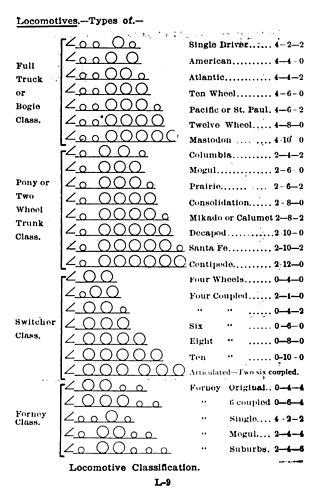
The Whyte notation is a classification method for steam locomotives, and some internal combustion locomotives and electric locomotives, by wheel arrangement. It was devised by Frederick Methvan Whyte, and came into use in the early twentieth century following a December 1900 editorial in American Engineer and Railroad Journal.

A 2-8-8-4 steam locomotive, under the Whyte notation, has two leading wheels, two sets of eight driving wheels, and a four-wheel trailing truck. The type was generally named the Yellowstone, a name given it by the first owner, the Northern Pacific Railway, whose lines ran near Yellowstone National Park. Seventy-two Yellowstone-type locomotives were built for four U.S. railroads.

A 4-8-8-4 in the Whyte notation for the classification of steam locomotives by wheel arrangement, is a locomotive with a four-wheel leading truck, two sets of eight driving wheels, and a four-wheel trailing truck. Only one model of locomotives has ever used this configuration, and that is commonly known as "Union Pacific Big Boys" after the railroad that operated them.
The UIC classification of locomotive axle arrangements, sometimes known as the German classification or German system, describes the wheel arrangement of locomotives, multiple units and trams. It is used in much of the world, notable exceptions being the United Kingdom, which uses a slightly simplified form of UIC, and in North America, where the AAR wheel arrangement system is used to describe diesel and electric locomotives. In North America, Whyte notation is only used for steam locomotives.
Locomotive classification on the Pennsylvania Railroad took several forms. Early on, steam locomotives were given single-letter classes. As the 26 letters were quickly assigned, that scheme was abandoned for a more complex system. This was used for all of the PRR's steam locomotives, and — with the exception of the final type bought — all electric locomotives also used this scheme.
Under the Whyte notation for the classification of steam locomotive wheel arrangements, a 2-10-10-2 is a locomotive with two leading wheels, two sets of ten driving wheels, and a pair of trailing wheels.

In the Whyte notation for classifying the wheel arrangement of steam locomotives, an 0-8-8-0 is a locomotive with two sets of eight driving wheels and neither leading wheels nor trailing wheels. Two sets of driving wheels would give far too long a wheelbase to be mounted in a fixed locomotive frame, so all 0-8-8-0s have been articulated locomotives of the Mallet type, whether simple or compound. In the UIC classification, this arrangement would be, refined to Mallet locomotives, (D)D. The type was sometimes called Angus in North America.

Under the Whyte notation for the classification of steam locomotives, 0-10-0 represents the wheel arrangement of no leading wheels, ten powered and coupled driving wheels on five axles and no trailing wheels. In the United Kingdom, this type is known as a Decapod, a name which is applied to 2-10-0 types in the United States. In the United States, the type is known as ten-coupled.
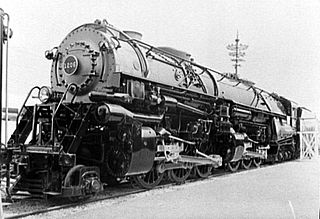
In the Whyte notation for the classification of steam locomotive wheel arrangement, a 2-6-6-4 is a locomotive with a two-wheel leading truck, two sets of six driving wheels, and a four-wheel trailing truck. All 2-6-6-4s are articulated locomotives, of the Mallet or related simple articulated type.
Under the Whyte notation for the classification of steam locomotives, 0-10-2 represents the wheel arrangement of no leading wheels, ten powered and coupled driving wheels on five axles, and two trailing wheels on one axle.
A 2-8-8-2, in the Whyte notation for describing steam locomotive wheel arrangements, is an articulated locomotive with a two-wheel leading truck, two sets of eight driving wheels, and a two-wheel trailing truck. The equivalent UIC classification is, refined to Mallet locomotives, (1'D)D1'. These locomotives usually employ the Mallet principles of articulation—with the rear engine rigidly attached to the boiler and the front engine free to rotate—and compounding. The 2-8-8-2 was a design largely limited to American locomotive builders. The last 2-8-8-2 was retired in 1962 from the N&W's roster, two years past the ending of steam though steam was still used on steel mill lines and other railroads until 1983.

Under the Whyte notation for the classification of steam locomotives, 4-2-2 represents the wheel arrangement of four leading wheels on two axles, two powered driving wheels on one axle, and two trailing wheels on one axle.

In the Whyte notation for the classification of steam locomotives by wheel arrangement, a 2-8-8-0 is a locomotive with a two-wheel leading truck, two sets of eight driving wheels, and no trailing truck.

In the Whyte notation for the classification of steam locomotive wheel arrangement, a 0-4-4-0 is a locomotive with no leading truck, two sets of four driving wheels, and no trailing truck. Examples of this type were constructed as Mallet, Meyer, BMAG and Double Fairlie locomotives. A similar configuration was used on some Garratt locomotives, but it is referred to as 0-4-0+0-4-0.

Under the Whyte notation for the classification of steam locomotives, a 4-8-8-2 is a locomotive with four leading wheels, two sets of eight driving wheels, and a two-wheel trailing truck.
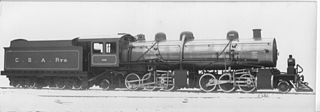
Under the Whyte notation for the classification of steam locomotives by wheel arrangement, a 2-6-6-2 is a locomotive with one pair of unpowered leading wheels, followed by two sets of three pairs of powered driving wheels and one pair of trailing wheels. The wheel arrangement was principally used on Mallet-type articulated locomotives, although some tank locomotive examples were also built. A Garratt locomotive with the same wheel arrangement is designated 2-6-0+0-6-2.
In Whyte notation, 2-4-4-2 refers to a railroad steam locomotive that has two leading wheels followed by four coupled driving wheels, a second set of four coupled driving wheels, and two trailing wheels.
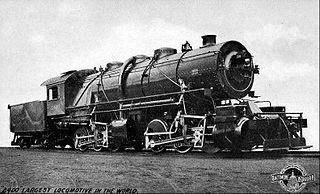
Under the Whyte notation for the classification of steam locomotives, a 0-6-6-0 wheel arrangement refers to a locomotive with two engine units mounted under a rigid locomotive frame, with the front engine unit pivoting and each engine unit with six coupled driving wheels without any leading or trailing wheels. The wheel arrangement was mostly used to describe Mallet locomotive types.
Under the Whyte notation for the classification of steam locomotives, a 2-8-8-8-4 has two leading wheels, three sets of eight driving wheels, and four trailing wheels.
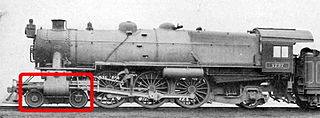
The leading wheel or leading axle or pilot wheel of a steam locomotive is an unpowered wheel or axle located in front of the driving wheels. The axle or axles of the leading wheels are normally located on a leading truck. Leading wheels are used to help the locomotive negotiate curves and to support the front portion of the boiler.













